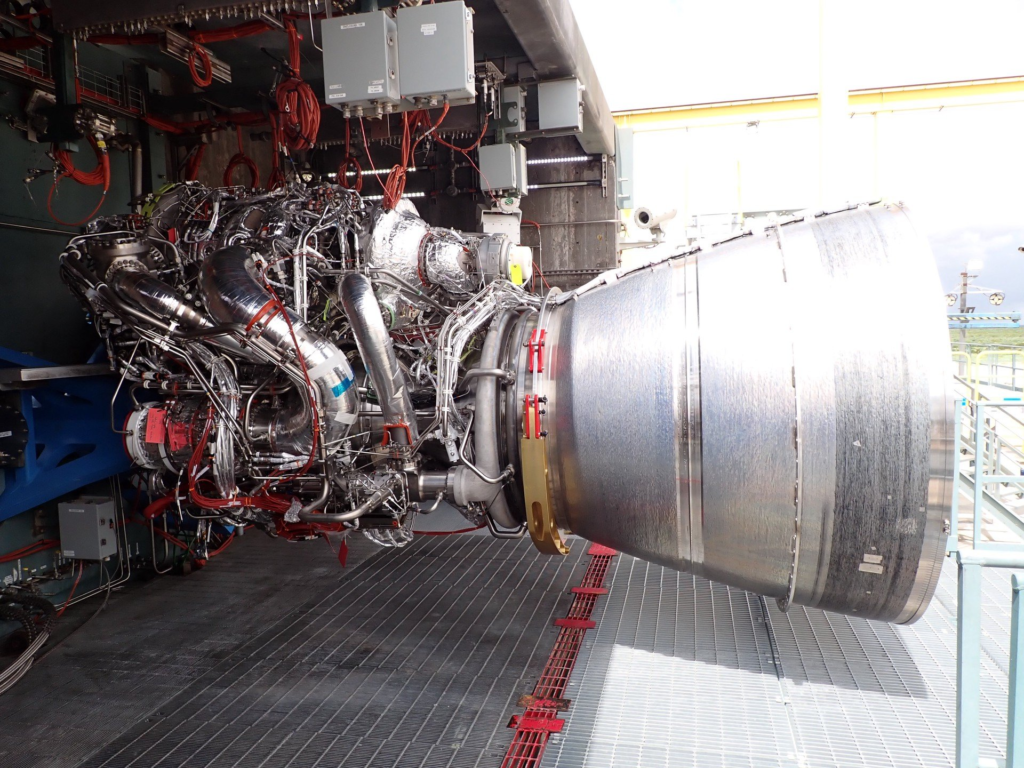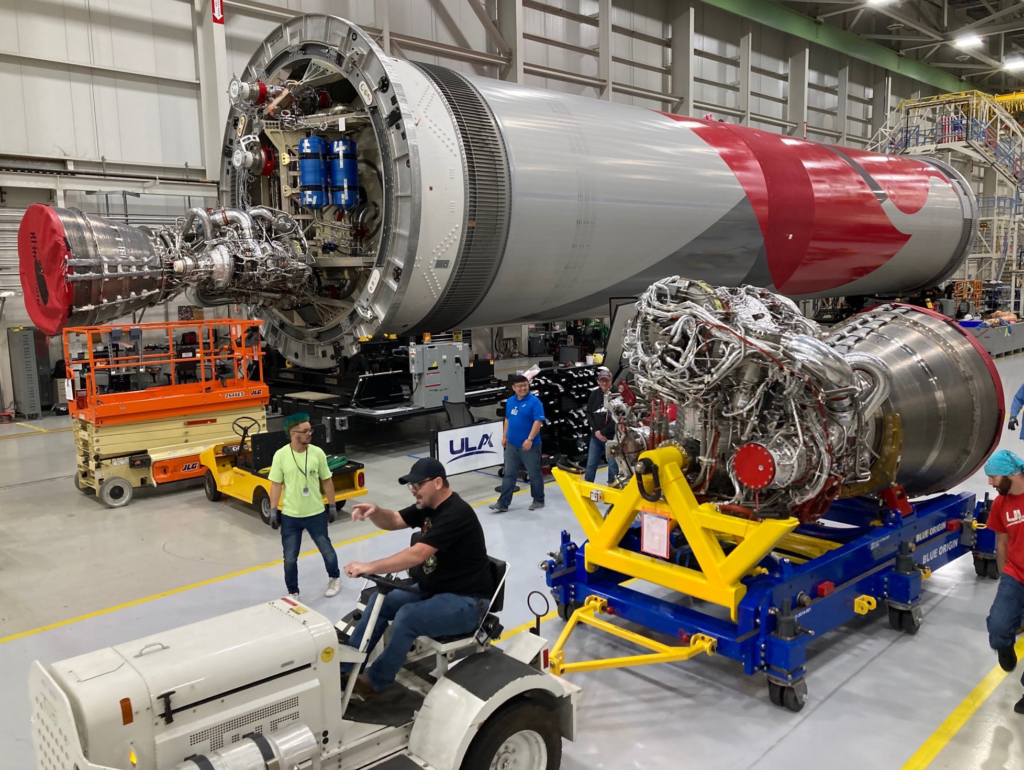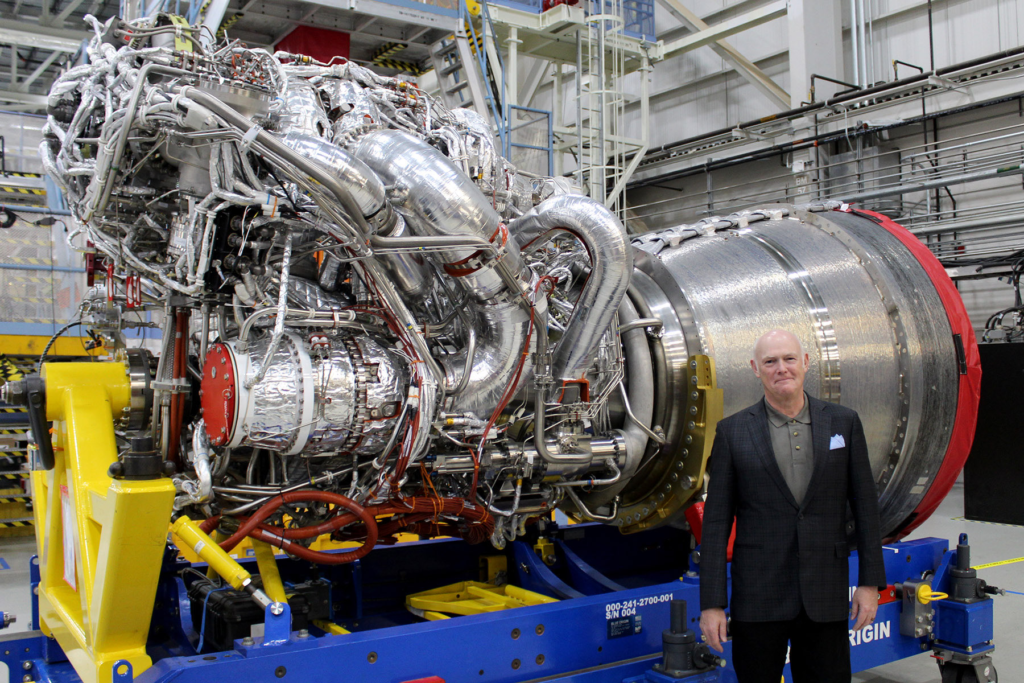
Blue Origin’s BE-4 Engine Is About To Launch For The First Time
It has been over a decade since the BE-4 engine began development. In the time since then, there have been quite a few setbacks along with important milestones. Something you would expect when attempting to create a next generation rocket engine hoping to power multiple future launch vehicles. All of which has led up to the engine’s most important test yet, Vulcan’s first flight.
Vulcan is a new rocket from United Launch Alliance set to lift off for the first time on May 4th. A deal between ULA and Blue Origin years ago facilitated the addition of BE-4’s engines on the first stage of Vulcan rather than Russian made hardware. Now in the final months leading up to this mission, the BE-4 engines are completing all the final tests and checks necessary.
These two BE-4 engines together generate 550,000 pound force of thrust per engine. After an extensive development and test history, they are almost ready for a historic launch and monumental moment for Blue Origin and its future projects. Here I will go more in-depth into the final BE-4 engine tests, the design of these engines, what to expect in the coming weeks, and more.
First BE-4 Launch

Two BE-4 flight engines were delivered to ULA for Vulcan in October 2022. However, before they were packaged and shipped to the company, they had a very busy and eventful lead up. Over a year ago work began on these two specific BE-4 engines. Between June and July, we saw some of the final manufacturing and assembly of this hardware. In late July 2022, ULA CEO Tory Bruno tweeted saying, “Wow. You guys really do like seeing rocket engines. OK, Flight Engine #1 (fully assembled) on the left. #2 (almost done) on the right.” This marked the final point prior to the initial testing of these two engines. Through August and September, both of these BE-4 engines began test firing at varying levels to make sure they were in perfect condition. Finally, after around 8 years since a deal between ULA and Blue Origin was made, the company received its first two flight ready BE-4 engines.
Just weeks after receiving the engines ULA had fully integrated them onto Vulcan’s first stage. By now, Vulcan is stacked at the launch site and completing some of its final tests before a flight readiness firing. As far as the two BE-4s, they are going through some prequalification activities. Just two days ago on the 24th Tory Bruno responded to a question regarding BE-4s activities and said, “In prequalification, we practice for the qualification, test beyond qualification levels to understand margins, and, for some conditions, test beyond qualification to better understand behavior. Adjustments are made, if necessary. One typically then comes back for a formal qualification, incorporating any changes made.” With brand new hardware comes new challenges and a lot of work. Rocket engines are an immensely complex and important piece of equipment that ULA and Blue Origin are trying to get right the first time.
In addition to the flight engines on Vlucan, two virtually identical BE-4 engines were sent from Blue Origin’s factory in Washington to Texas. These “qual” engines have been undergoing a much more rigorous series of tests known as qualification testing. In this case, the idea was to push the qualification engines through their paces, and beyond their expected flight environment, to find any issues. During this series of tests, Bruno said, the oxygen pump on one of these engines has consistently produced about 5 percent more oxygen into the engine than expected. This fell outside the bounds of nominal performance but had only been observed in this engine. In a quote, he said, “We’ve arrived at the conclusion that this is simply likely unit-to-unit variation. The other engines, including the flight engines that are on the rocket right now, are all very similar, and of that earlier family that did not have an extra 5 percent of output coming out of the main oxygen pump. Now we’re satisfied, and we’ll resume testing shortly with the other engine. That testing sequence will run about six weeks.”
As far as the progress on this launch, it’s coming along very well. Integrated testing of the rocket stages, VLP, and ground systems will be conducted within the VIF over the next few weeks before Vulcan rolls out to Space Launch Complex (SLC)-41 to undergo a series of fuel-loading and countdown exercises. The testing culminates with a Flight Readiness Firing (FRF) to practice the full day-of-launch timeline complete with a brief ignition of the rocket’s main engines. This will be the final big step for the two BE-4 engines. If they perform as expected and ULA is confident, they will move on and get ready for launch. After the FRF, the rocket will return to the VIF for the installation of two solid rocket boosters and its payload for launch. The first launch will send Astrobotic’s Peregrine commercial lunar lander to intercept the Moon, deploy two Project Kuiper prototype broadband satellites into low Earth orbit for Amazon, and carry a Celestis memorial payload into deep space.
While the two solid rocket boosters will be adding additional thrust, the two BE-4 engines will be doing the majority of the work and are responsible for this mission. The results of this mission could have both a very positive and negative impact on BE-4’s future. As I speak, Blue Origin is heavily ramping up the production of the engine. Ideally, they launch without a hitch and continue to be produced going forward.
Next-Gen Engine

The development and testing of the BE-4 engine have not been perfect. Many different delays and company errors have pushed back its completion and halted various opportunities. While not ideal, Blue Origin has continued to create and test this next gen engine. With two future launch vehicles relying on it, production has become the main focus for the company. After the flight engines were delivered to ULA, Blue Origin released a statement saying, “This state-of-the-art engine will end reliance on Russian engines and power a new generation of U.S. launch vehicles. Dozens of these engines are now in production to support a large and growing demand for civil, commercial, and defense launches.”
It’s important to point out that United Launch Alliance has priority when it comes to receiving these engines. Based on the fact that Vulcan is not reusable, each new Vulcan launch will require additional BE-4 engines. This is a very big deal, especially considering new information from ULA and Tory Bruno regarding Vulcan’s future launch cadence. In another quote, Tory Bruno said, “We have to ramp up. Before the end of 2025 we expect to be really at a tempo, which is flying a couple of times a month, every two weeks.” This is going to put quite the strain on Blue Origin who will need to produce enough capable BE-4 engines for Vulcan’s busy schedule along with any New Glenn rocket which requires an additional 7 BE-4 engines on the first stage. This is exactly why production will determine the success and future of this engine.
As far as design, Blue Origin is building BE-4 in a manner that facilities refurbishment and reuse. They point out that BE-4 was designed from the beginning to be a medium-performing version of a high-performance architecture. It’s a conscious design choice made to lower development risk while attempting to meet performance, schedule, and reusability requirements. The company highlights that its hardware-rich approach, multiple developmental units, and redundant test stands enable a high test tempo and rapid learning. Something we will have to see to believe in the future as demand increases heavily. As far as the propellant, they chose LNG because it is highly efficient, low cost, and widely available. Unlike kerosene, LNG can be used to self-pressurize its tank. Known as autogenous repressurization, this eliminates the need for costly and complex systems that draw on Earth’s scarce helium reserves. LNG also possesses clean combustion characteristics even at low throttle, simplifying engine reuse compared to kerosene fuels.
The opportunity for reuse is the most realistic and best option for Blue Origin. In ULA’s case, it’s possible that by the time Vulcan is reaching record numbers in terms of launch cadence, a reuse design has been implemented. Recently on the topic of reusability, Tory Bruno commented, “You will see us potentially do more demonstrations. We’ll be collecting environmental data to see booster experiences. We’ll recover engines and look at them. And then eventually we’ll have the confidence to recover them, inspect them, and then reuse them. And so that will happen in this window of a few years, but it’s too early at this moment for me to say exactly when. But you’ll see that activity ramp up.”
The method ULA has been considering is called SMART Reuse. This process involves the separation of the engines and the bottom portion of the rocket. After separation, the nose assembly extends to position the Hypersonic Inflatable Aerodynamic Decelerator (HIAD) such that it will clear the separation plane when inflated. Preliminary results indicate a 10- 12 meter HIAD will be required to recover the booster module. From here, it would continue through Earth’s atmosphere before parachute deployment. This would slow down the two BE-4s and additional technology significantly before a planned soft water landing. Here they would float on an inflatable aeroshell before being recovered by ULA and taken back to land for refurbishment.
Conclusion
Blue Origin is months away from the most important test BE-4 has ever been apart of. Right now the engines are performing some of the final tests before the first launch of Vulcan using two BE-4 flight engines. For over a decade, these engines have been developed, tested, and now put in place for an actual mission. We will have to wait and see how it progresses and the impact it has on the space industry.
